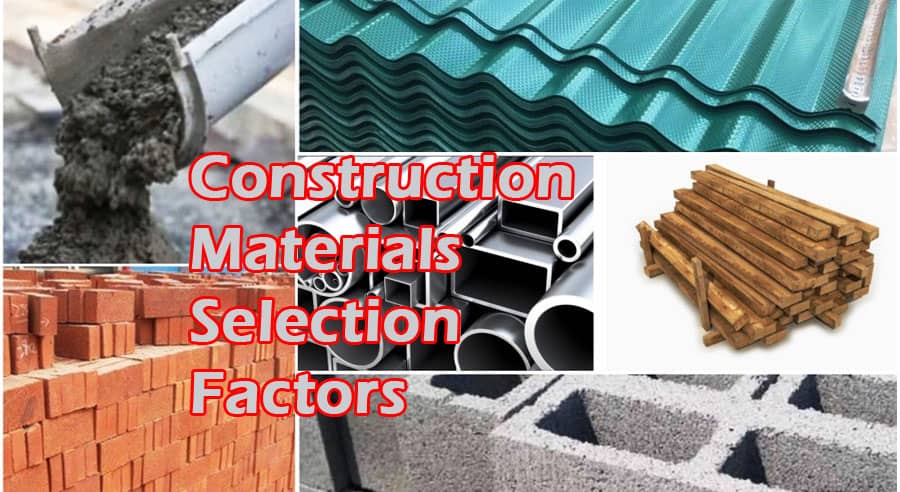Construction Materials Selection Factors

It is important to use high quality building materials when building structures that are strong, durable, serviceable, and aesthetic. As a result, project and maintenance costs can also be greatly affected. In order to meet the objectives of the design and specification documents, materials should be carefully selected.
Since a wide range of construction materials are available on the market, selecting the right option for the building's specific needs can be challenging. To select suitable construction materials for a project, considerations such as strength, durability, local availability of materials, cost, handling, and storage must be taken into account.
Construction Materials Affecting Factor
Durability
Materials that are durable and require minimal maintenance are essential when building structures that will last a long time. Certain materials may cost more initially, but they may cost less to maintain in the long run. Materials are handled and stored in such a way that affects cost and labor requirements as well.
Materials Availability Locally
The availability of materials locally affects construction costs and schedules. Unless materials are ordered in advance, transportation costs will be high if they are far from the construction site. Construction will run more smoothly with local materials, and transportation costs will be reduced.
Proper Skills
Decision-makers should be aware of the skills required to use construction materials they select. The cost of construction increases when skilled labor is required. Moreover, construction work is delayed if skilled labor is unavailable, which is common in remote areas.
Strength
It is important to select construction materials that are strong. Testing demonstrates a material's resistance to stress by compressing, tensioning, and shearing it.
Contractors can choose from a variety of steel grades based on their needs, for example. In buildings that do not have to carry heavy loads, low steel grades can be used. The availability of steel on the market will, however, play an important role in this process.
Climate
The climate is another important factor to consider when choosing materials. A few of the parameters to consider are average temperature range throughout the year, rain, snow, amount of sunlight, ventilation requirements, and wind.
There is a relationship between the climate and the properties of building materials. The materials used should be appropriate for the climate of the region where the structure will be built.
Specifications
It is also important to consider specifications when selecting materials. In determining material specifications and quality for a project, strength, aesthetic appearance, durability, etc., are taken into account.
If a structure is constructed in a tidal zone, specifications may call for a cement type that resists chloride and carbonation attacks. It may be necessary to add additives or supplementary Cementitious materials in this case.
Aesthetic Look
Building appearance is determined by the type of material used. There may be someone who finds a particular appearance attractive, but there may also be someone who does not find it attractive.
Thus, the building's owner's demand is an important factor here as he or she may have decided what type of appearance is desirable. Material selection influences the floor's appearance, so choosing the right material is important.
You can choose from a variety of flooring materials, such as granite, marble, vitrified tiles, ceramic tiles, wood, and Kota stone. The price of the material may limit your options since the most attractive floor material may also be the most expensive.
Sustainability
Due to the demand for reducing carbon emissions, sustainable development is continuously becoming more important. Codes and standards are constantly tightening carbon emission specifications. Due to these factors, decision-makers tend to choose sustainable materials such as fly ash, ground granulated blast furnace slag, and silica fume, which use less cement and emit less carbon dioxide.
Maintenance
It is sometimes maintenance that determines material selection due to the fact that not only do good materials require low maintenance costs, but they also maintain the building's aesthetic appeal. When choosing materials, it is important to consider services and support after sales. You should check if the seller offers support and services, such as normal and annual repairs and spares.
Recycling
In selecting materials, it is important to consider their ability to be recycled at the end of their lifecycle. As an example, designers and developers should choose bolted steel connections over welded steel connections. Despite requiring a greater amount of effort and accuracy, the former is completely recyclable. It is very difficult to recycle the latter without releasing more carbon into the atmosphere.
Wrapping it Up
You should ensure the right material selection by understanding a product description, its technical specifications, and its terms and conditions of guarantee. It is sometimes possible to misunderstand what is understood by a material selector or presented by a salesperson. Because masonry bricks are the primary load bearing element of a load-bearing structure, you should choose high-quality bricks.
